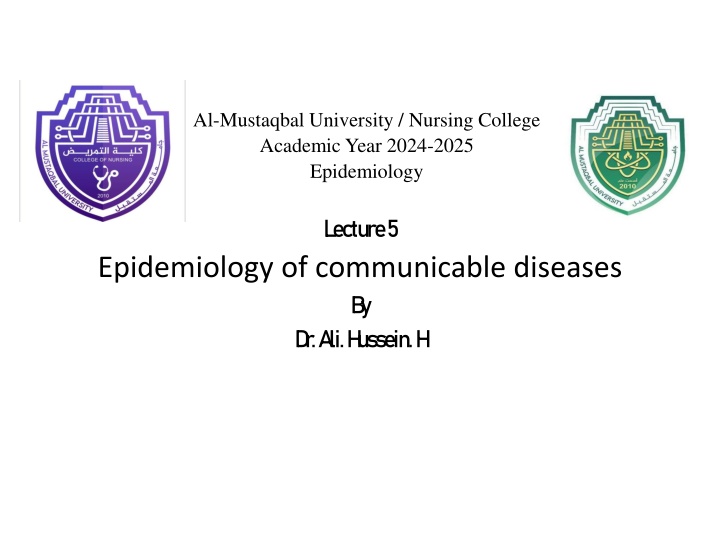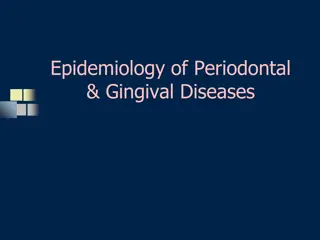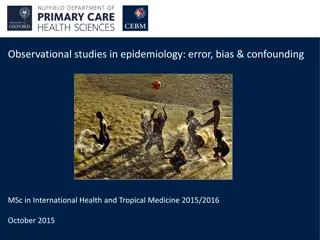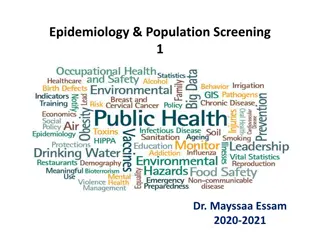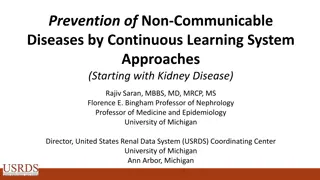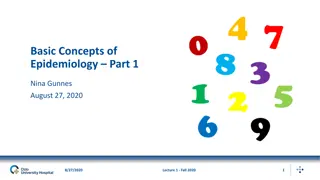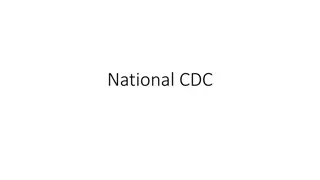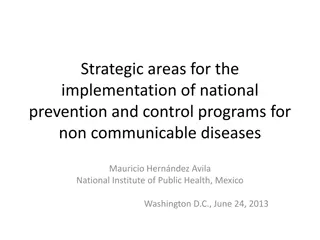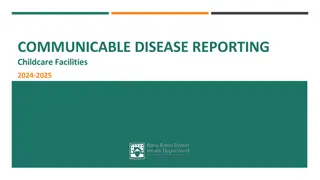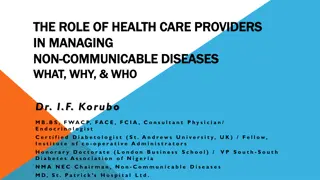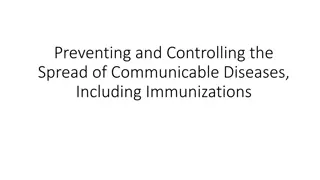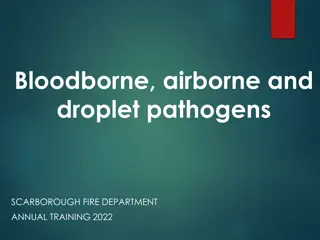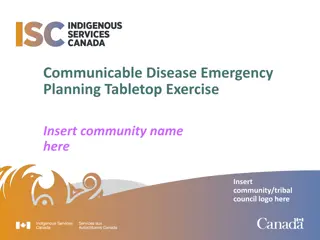Epidemiology of communicable diseases
Communicable diseases spread through various modes of transmission such as direct contact and contaminated water or food. Recognizing signs and symptoms is crucial for prompt intervention and control. Learn about epidemiology, contagious diseases, and incubation periods in this insightful lecture by Dr. Ali Hussein H.
Download Presentation

Please find below an Image/Link to download the presentation.
The content on the website is provided AS IS for your information and personal use only. It may not be sold, licensed, or shared on other websites without obtaining consent from the author.If you encounter any issues during the download, it is possible that the publisher has removed the file from their server.
You are allowed to download the files provided on this website for personal or commercial use, subject to the condition that they are used lawfully. All files are the property of their respective owners.
The content on the website is provided AS IS for your information and personal use only. It may not be sold, licensed, or shared on other websites without obtaining consent from the author.
E N D
Presentation Transcript
Al-Mustaqbal University / Nursing College Academic Year 2024-2025 Epidemiology L ecture 5 Epidemiology of communicable diseases B y D r. A li. H ussein. H
Communicable disease: An occurs due to specific infectious agent or its toxic products which develops through transmission of that agent or its toxic products from a reservoir to a susceptible host either directly or indirectly. examples of diseases include food and water- borne disease, and Lyme disease.
Contagious disease (infectious disease): - capable of spreading from one person to another. examples of contagious diseases are chickenpox, malaria, flu, and pertussis.
Incubation period Incubation period The interval between exposure and first clinical manifestation. The time between exposure and first clinical manifestation is the minimum incubation period. The time between exposure and the last clinical manifestation , maximum incubation period.
Communicable communicability ) The time interval during which an agent may be transferred directly and indirectly from a host to another. period (period of
Signs and symptoms of infectious diseases: The signs and symptoms of an infectious disease vary greatly, depending on the pathogen that caused the infection. Fever and fatigue are common symptoms, but infections can cause a wide range of symptoms, ranging from mild to severe and sometimes life-threatening (very sever).
Direct mode of transmission Direct mode of transmission If a certain person gets infected in the presence of the reservoir, i.e. the organism transmit from one host to another without any intervening period, then the transmission is said to be direct.
1 1. Person to person contact: . Person to person contact: The organism spreads by contact with breached (broken) epithelium, most sexually transmitted diseases can also be transmitted by this kind of contact.
2 2. . Droplets Droplets micro particles Droplets secretions, which, when coughed or sneezed out, are blasted into air with high velocity and inhaled by anyone nearby. of respiratory Most tuberculosis) are spread by droplets. respiratory infections (diphtheria, infections are difficult overcrowded population. to control in an
3 3. Contact with soil . Contact with soil
4 4. Inoculation in anybody fluid: . Inoculation in anybody fluid: This gives the organism the most direct access to circulatory system. For example, hepatitis B and HIV are secreted in all body fluids and if the body fluids of a patient (blood/ serum/ CF/ saliva/ semen/ vaginal secretion).
Trans placental: Trans placental: the transmission of pathogens that are transferred from the mother to the fetus through the placenta hepatitis B). However, some organisms can cross the placental barrier in early pregnancy resulting in fetal malformation or abortion (rubella, chickenpox). example of (HIV,
Indirect mode of transmission: Indirect mode of transmission: indirect contact transmission occurs when there is no direct human-to-human contact. Contact occurs from a reservoir to contaminated surfaces or objects, or to vectors such as mosquitoes, flies, mites, fleas, ticks, rodents or dogs
The methods of indirect transmission are : The methods of indirect transmission are : 1- Vehicle Inanimate objects he term vehicle transmission refers to the transmission of pathogens through vehicles such as water, food, and air. Water contamination through poor sanitation methods leads to waterborne transmission of disease. for example, a certain contaminated water source causing diarrhea in everybody who drank it . Example Cholera, Typhoid. Hepatitis A
2 2- - Vectors Vectors An intermediate organism which transports a micro-organism between two hosts. Examples include Man mosquitoes man (malaria) Rat flea man Man sand fly man (leishmaniasis).
3 3- - Airborne route Airborne route A -Droplet nuclei the residue of dried droplets that may remain suspended in the air for long periods, may be blown over great distances, and are easily inhaled into the lungs and exhaled. e.g. the droplets sneezed out by an influenza or CORONA virus patient into his bed, remains infective.
B - Dust :carries with it the Streptococcus bacilli, fungal spores, and tuberculosis bacilli; because dust is a frequent cause of nosocomial infections.
4- Fomites: are any inanimate object except food and water (like clothes, utensils and personal belongings of a patient) that bear germs and spread the disease. 5- Fingers The importance of clean hands can not be overstated
The factors that affect indirect The factors that affect indirect transmission are: transmission are: 1. Viability of the agent How long can it survive without any host to sustain it? 2. Virulence of agent How dangerous can it still remain after the period of external survival? 3. Environment Is the environment suitable for survival of the organism?
The general strategies to control communicable diseases: 1. Elimination source of infection : by effective detection and treatment of cases and carriers or dealing with any other source. 2. Interruption of transmission path ways: for example by the destruction of intermediate hosts, destruction of breeding sites and purification of water. 3. Improvement of host resistance or immunity against infection as for example by immunization
